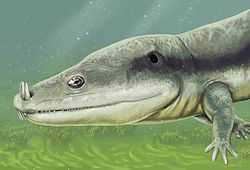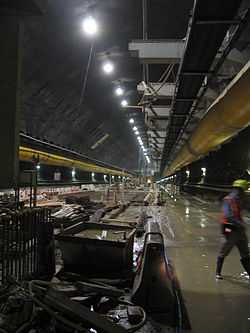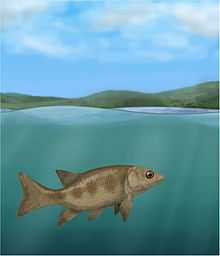Ashfield Shale
Ashfield Shale is part of the Wiannamatta group of sedimentary rocks in the Sydney Basin. It lies directly on contemporaneously eroded Hawkesbury sandstone or the Mittagong formation. These rock types were formed in the Triassic Period.[1] It is named after the Sydney suburb of Ashfield. Some of the early research was performed at the old Ashfield Brickworks Quarry. This rock type is often associated with the Inner West and North Shore of the city. However, it has also been recorded at Penrith, Revesby, Bilpin and Mount Irvine.
Description
Ashfield Shale comprises black mudstones and grey silty shales with frequent sideritic clay ironstone bands. The depth ranges between 45 and 64 metres.[1] Though it is recorded at 20 metres thick at the Sydney Olympic Site.[2] The chemistry of the rock is typical of shales, with high iron levels, and some iron sulphide and low calcium levels. The geology of the shale lenses within the Hawkesbury Sandstone is chemically similar to the Ashfield Shale.[1]
Small scale bedding is abundant. The shales are sandy at the top of the sequence. There are up to ten bands in a fifteen metre section. The fine grained silty sediments were laid down in a low energy, south-east flowing deltaic setting, near the shores of a shallow sea.
There is no natural selection in which the Ashfield Shale is completely exposed. However, it can be seen at railway and roadside cuttings, as well as old quarries. With weathering and exposure, the shale becomes a paler colour.
Weathering of the shale units produces a reddish/brown podsolic soil, often with poor drainage, such as that in the Cumberland Plain.[3] These clay soils are recognised as being reactive with an appreciable shrink-swell capacity.
Engineering and construction
The adjacent Hawkesbury Sandstone is considered a safer bedrock than the (less stable and laminated) Ashfield Shale for building construction. In 2005 the construction of the Lane Cove Tunnel was affected by the collapse of an exit ramp excavation, through Ashfield Shale.[4] Difficulties may be encountered where the Ashfield Shale interfaces with the Hawkesbury Sandstone and the Mittagong Formation.[5]
Flora
Ashfield Shale is associated with the critically endangered Blue Gum High Forest and Sydney Turpentine-Ironbark Forest.[6][7]
Industry and agriculture
In the earlier days of Sydney, the Ashfield Shale supported a number of quarries. The shale provided a suitable raw material for brickmaking.[6] Sydney soils based on shale are not particularly fertile. But at Parramatta they proved more suitable to agriculture than those at Farm Cove, in the early days of the First Fleet.
Fossils
Ashfield Shale is considered a freshwater lacustrine paleoenvironment. It was gradually inundated by brackish water, then shallow marine waters over a long period of time.
Fossils are not common in this stratum, however, fossil bivalves, plants, isopods, insects and amphibians have been recorded. One outstanding example being of a Paracyclotosaurus[1] at St Peters, 2.25 metres long. It is one of the most complete mastodonsaurid skeletons ever recovered. Notobrachyops is a genus of brachyopid temnospondyl amphibian. It is known from a skull roof impression found in the Ashfield Shale at the old Hurstville Brick Company quarry at Mortdale.
The Ashfield Shale has also yielded a shark species, a lungfish species, six species of paleoniscid fish, a species of holostean fish, and a subholostean fish.[8]
Fossil fauna
| Insects of the Ashfield Shale | ||||
|---|---|---|---|---|
| Taxa | Presence | Description | Images | |
|
Order:
|
||||
|
Family:
|
||||
|
Family:
|
||||
|
Family:
|
||||
|
Family:
|
||||
|
Family:
|
||||
|
Order:
|
||||
|
Order:
|
||||
|
Order:
|
||||
| Bivalvia of the Ashfield Shale | ||||
|---|---|---|---|---|
| Taxa | Presence | Description | Images | |
|
Family:
|
||||
| Sharks of the Ashfield Shale | ||||
|---|---|---|---|---|
| Taxa | Presence | Description | Images | |
|
Family:
|
| |||
| Fish of the Ashfield Shale | ||||
|---|---|---|---|---|
| Taxa | Presence | Description | Images | |
|
Family:
|
| |||
|
Family:
|
| |||
|
Family:
|
||||
|
Family:
|
||||
|
Family:
|
||||
|
Family:
|
||||
|
Order:
|
||||
| Amphibians of the Ashfield Shale | ||||
|---|---|---|---|---|
| Taxa | Presence | Description | Images | |
|
Family:
|
| |||
|
Family:
|
 Microposaurus averyi | |||
|
Family:
|
||||
| Reptiles of the Ashfield Shale | ||||
|---|---|---|---|---|
| Taxa | Presence | Description | Images | |
|
Family:
|
||||
|
Family:
|
||||
|
Family:
|
||||

References
- ↑ 1.0 1.1 1.2 1.3 Packham (editor), Gordon Howard (November 1969). The Geology of New South Wales. Sydney: Geological Society of Australia. pp. 417–421.
- ↑ "Geological History". Sydney Olympic Park Authority. NSW Government. Retrieved 23 July 2012.
- ↑ Fairley A, Moore P (2000). Native Plants of the Sydney District:An Identification Guide (2nd ed.). Kenthurst, NSW: Kangaroo Press. p. 19. ISBN 0-7318-1031-7.
- ↑ "Lane Cove Collapse". Tunnel Talk. Retrieved July 22, 2012.
- ↑ "Recent Experiences in Grouting Sydney Sandstone". Australian Tunnelling Society. ats.org.au. Retrieved July 23, 2012.
- ↑ 6.0 6.1 John Johnson (2008). "Croydon". Dictionary of Sydney. Dictionary of Sydney Trust. Retrieved 23 July 2012.
- ↑ "Blue Gum High Forest - Typical Form". Mapping and Assessment of Key Vegetation Communities Across the Ku-ring-gai Local Government Area. Ku-Ring-Gai Council. Retrieved 23 July 2012.
- ↑ Cosgriff, J. W. (1973). "Notobrachyops picketti, a brachyopid from the Ashfield Shale, Wiannamatta Group, New South Wales". Journal of Paleontology 47 (6): 1094–1101.


